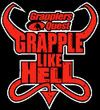WCF: UNSTOPPABLE VS. IMMOVABLE

By Matt Wiggins
The Unstoppable Force vs. The Immovable Object
Catchy title, huh? But wasn't it for a pro-wrestling match? I don't remember...either way...Watcha gonna do, BROTHER, when the biggest sandbag in the world falls on you!!
*hulks up and flexes*
Um, anyway, uh...let's get to this week's column...yeah...This week, I want to get into something that will hopefully stick in your mind when designing strength programs and trying to figure out what kind of exercises to use.
In any resistance exercise, you have three things present: a movable object, an immovable object, and the force generated between the two. In most cases, the movable object is the resistance itself – a barbell, a dumbbell, a sandbag, your body (in bodyweight calisthenics), or even the limb you're moving (in the case of using resistance bands or surgical tubing).
Again, in most cases, the immovable object is either the ground or a piece of equipment – more on this in just a little bit.
The force generated between the two is caused by you, the trainee. You brace yourself (either standing and using your musculature, or by being on or holding onto a piece of equipment) on the immovable object, and move the movable object. You are causing there to be a greater distance between the movable and immovable objects.
Let's take a look at an example or two:
You deadlift a barbell (BB). The BB is the movable object, because, well, you can move it. The ground is immovable. Since you're moving the barbell, you're the producing the force causing there to be distance between the two.
Let's say you're doing chins. Your body is the movable object, as it's what is being moved. The chin bar is the immovable object (a piece of equipment secured to the ground). And once again, you're producing the force between the two. In this instance, the distance between your body and the chin bar isn't increased - rather it's between your body and the ground (which, because the chin bar is connected to it, is an extension of the chin bar).
Now, this might seem kinda basic – sort of one of those “Yeah, well no kidding, Wiggy” type of things. But let's look at it a little more...
When designing the strength portion of programs, it is can be a good idea that exercises are chosen that can have some direct carryover to MMA. For example, since punching power starts at the hips/waist, you might want to incorporate some sledge hammer strikes or twisting medicine ball throws to help increase power output. And heavy sandbag shouldering will help you built the strength you might need to pick up and slam your opponent.
Other “basic” lifts such as squats, overhead presses, rows, etc. build good overall basic strength. The strength built can be applied to MMA (strong and powerful legs, for example, can help make you more explosive for quicker takedowns), but there is not necessarily any direct carryover.
Both kinds of exercise (those that directly carryover and those that don't) are fine – neither is necessarily “better” than the other. They are not mutually exclusive – they're just different.
Now, sometimes I read that certain exercises will have more carryover because the movement may somewhat mimic an MMA skill. This is where the idea of movable and immovable objects, as well as force applied between the two comes in.
(Read More)






















No comments:
Post a Comment